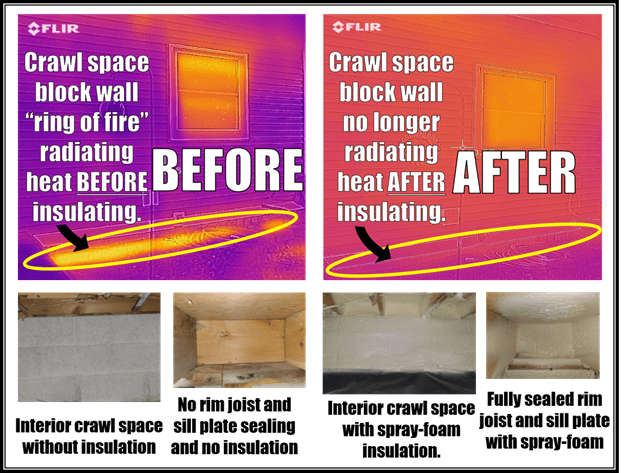Published 3/11/2021
We’ve reached early spring here in Michigan! Some would call this “Fool’s spring” as Michigan teases us with an early warm up in anticipation of the warm days to come, only to remind us harshly that “we’re not out of the Michigan wood’s yet” with an icy cold snap followed by more snow. Ah yes, the dreaded March and April reminder that we get to deal with dramatic weather fluctuations in Michigan. But fear not, let’s look at how we can save energy here in Michigan in the spring, and actually continue to realize a savings into summer…
Previously I shared an infrared thermal view of the heat loss radiating from a crawlspace block wall when viewed from the exterior. As a reminder, infrared allows us to visually see the heat signature of thermal energy as it displays the electromagnetic energy emitted by objects. Now I have a pretty amazing “qualitative” comparison to share of the before and after results of insulating this space! It’s important to understand that this is not “quantitative,” but only “qualitative.” Meaning I don’t have a before and after BTU loss comparison for you, but I do have undisputable visual evidence of the benefit of insulating the crawl space.
This is cool stuff, take a look at the photos below.

The ugly and expensive “ring of fire” around the crawlspace is gone after spray-foam insulating it! (Big shout-out and special thanks to “Lock-in / Lock-out” spray foam from West Branch Michigan for their work adding the spray-foam in this picture.) This will directly result in more savings for the homeowner. Opinions vary regarding exactly how much you can actually save, but many agree that it can be between 15% and 35% savings when properly sealed and insulated compared to an uninsulated crawlspace. Now that’s substantial.
And just because spring is right around the corner and summer will be here before you know it, doesn’t mean that this energy savings can only be realized in the winter. When you begin cooling your house this summer this insulated crawl space will continue to save you money. By insulating the crawl space, you are preventing your cool conditioned air from escaping through your crawlspace.
And you probably don’t consider this, but just as important and actually even more important to the integrity of the structure of your home is the fact that sealing the perimeter coupled with a properly installed vapor barrier on the dirt floor will prevent moisture intrusion. This is especially critical in the summer when the outside warm moist air tries to infiltrate your crawlspace.
So again – take a bite out of your high energy cost, both in the winter and summer by considering fully insulating your crawl space. Reach out to Elite Inspection Services if you’d like a similar evaluation done on your home. In the future, I expect us to become fully trained in home energy auditing where I can further enhance our services to NE Michigan customers.
If you think we can help you isolate heat loss areas in your home with our infrared thermal camera technology, give us a call – we’d be happy to take a look.
Published 12/28/2020
Here in Michigan as we get ready to step into yet another cold and seemingly endless steely gray sky until winter possibly releases its chokehold and May finally reaches us, we begin thinking about our winter heating bills. Yes, those dreaded propane, natural gas, fuel oil or ‘whatever fuel we use’ bill’s shows up in our mailbox like clockwork just like the snow in our driveway – much too often. So how can we combat that inflated bill that seems to get worse every month, (and it does)? Several things. Let’s start with those who live either on a basement or crawl space under us, which is most of us… If your home wasn’t built in the recent past, there’s a high likelihood that your foundation rim-joist area isn’t properly insulated. Below is a picture describing your typical rim joist area that wraps around the outer perimeter of your home. Note that this photo shows no insulation, which is common on many homes.

Insulating this is a simple, yet highly effective way in which you can reduce your energy heating loss in your home. In fact, some would tell you that you lose more heat through this area than you do through all of the windows in your house. To help prove this point, take a look at this infrared image below capturing the heat loss through this home’s crawl space. Do you see that horizontal line of “fire” on the bottom? That happens to be “cold cash” flying away via radiated energy loss through the crawl space block wall! (This home has no rim joist insulation.) Thermal imaging tells’ the real story:

Yes, that’s substantial. So just how easy is it to insulate this area? There are several different options to you as a homeowner to seal this area. And a couple of them our DIY ideas that could save you even more.
- Spray foam. This is really not a DIY project, unless you’re very adventurous and willing to consider purchasing a DIY spray foam kit? There are several contractors available today that make this service available, and some may be very reasonable compared to the other alternatives. Spray foam can be in the form of open cell or closed cell with the closed cell being the most energy efficient, (up to R7 per one inch of insulation.) The additional benefit of spray foam is that it’s a one step process as it both seals and insulates at the same time. (No need to caulk!) If you are doing this in a basement, and you have plans to finish the basement then you need to check your local building codes, as there may be fire rating requirements that must be met before finishing over this system.
- Batt insulation. This is a possible DIY task and yes, you can stuff batt insulation in this area as well. Keep in mind, if you do this you’ll need to caulk and seal off the rim joist to floor interface, as well as the rim joist to sill plate. You’ll also need to seal off the area between your sill plate and concrete foundation. All of these areas are prone to air infiltration if not sealed. 6” fiberglass batt is recommended. High performance R21 is available in 6” in batt insulation.
- The other DIY’er choice is rigid foam board. Simply purchase 4×8 sheets of 2” thick and cut it to size in the rim joist area. You can stack two layers of this to double your insulating value too. Just like batt insulation, you’ll need to caulk/seal all of the same joints mentioned above or you’ll be dealing with the same air infiltration issue. You can use cans of spray foam to act as an adhesive to install your rigid foam board. Actually, the spray foam can also double as your caulk/sealer for the aforementioned air infiltration joints as well.
So, take a bite out of your high energy bills this winter with a little proactive effort at curbing the heat loss. In a future blog I hope to post a before and after picture of the crawl space heat loss change once the rim joist insulation is complete. No doubt this will provide a telling story of “before and after.”
By the way – if you think we can help you isolate heat loss areas in your home with our infrared thermal camera technology, give us a call – we’d be happy to take a look.
